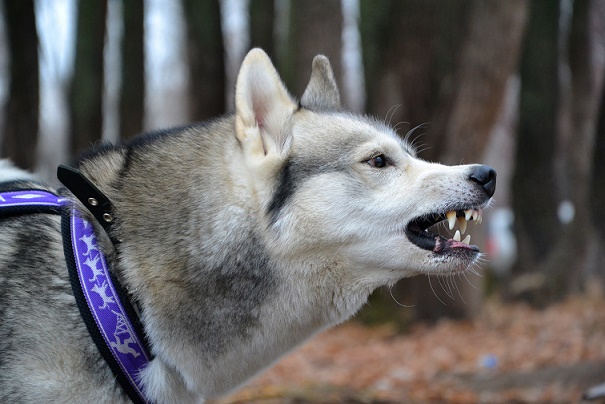by Patty L. Fletcher
Hi, Patty and Seeing Eye Dog Campbell here, back to talk to you about more dog handling issues, and tips to solve them. Today our topic is how to make a dog with aggression issues able to live in a home with other animals and children.
Many times a dog’s aggression is brought on by feelings of insecurity that have been brought about by abuse and neglect. When dealing with a dog of this nature, it is important to remember certain things. First off too much stimulation at one time is not going to bring about anything but more of the undesired behavior. So if for example, the dog in question has a habit of barking, growling, and lunging violently at others, you won’t want to put them in large groups to begin with. The trick is to help the dog feel secure. Keeping the dog with you at all times, and helping it learn its boundaries is a great way to help the dog feel more secure in its surroundings, and will also help to build its trust in humans. The best way to accomplish this task is to simply place the dog on a leash and keep it with you as you go throughout your daily activities. If it is not feasible for you to keep the dog connected to you in some way, keeping a tie out lead in each room of your home, or office so the dog can be with you in each room is a great place to start.
After about two to three weeks of only having the dog off of a tie out lead when you are walking it, you can begin to give short amounts of freedom. Allowing the dog short amounts of freedom after relief times and feeding times for ten to fifteen minutes at a time to start and adding time every other day in five minute increments is a great way to teach the dog its boundaries. Putting the dog back on tie out lead when it misbehaves to teach it what is not acceptable in the world in which it lives is a fabulous way to teach it the boundaries it must learn to respect to live within a home.
If there are children in the home, you absolutely DON’T want to start free time with the children present. As with children, if there are other animals in the home, the dog doesn’t need its first free times to happen when these animals are present either. Having children and other pets or working animals present when a dog being rehabilitated and introduced to new surroundings are free only sets the dog in question up to fail.
Another thing that will absolutely set the dog in question up to fail is leaving it alone while free to begin with. If the dog doesn’t know how to behave correctly when you are with it, it surely doesn’t have any idea what it can and cannot do while you are away, so tying or crating the dog while you are gone is not harsh, rather it is a kind thing to do, because if the dog is unable to be free it cannot get into trouble, and will not need to be corrected.
Once you see the dog can be trusted to be off a tie out for long periods of time, you can begin to slowly introduce it to other animals in the home and children as well. This needs to be done slowly, and with the dog on a leash. The dog doesn’t need to be tied when these introductions take place because if the dog is tied, the dog is going to feel trapped. You should keep the dog leashed, and whomever is responsible for the rehabilitation training and care for the dog needs to be the holder of the leash.
Having the dog on leash rather than tied gives the dog a sense of freedom because it can move about and is not tied in one place.
Little by little you may begin to allow free times while animals and children are present, but DON’T under any circumstance leave the dog and other animals and children unsupervised. This is a recipe for disaster and should be avoided at any cost. Only when you are absolutely one-hundred percent sure of the dog’s behavior and that it knows exactly what is expected of it can you begin to allow free times with other animals and children present.
Consistency is absolutely a must when doing these things. Having everyone in the home on the same page about what the dog in question is and is not allowed to do, and the commands it is expected to obey is an absolute must.
If you follow these tips, you are sure to have a dog you can keep for your own family to enjoy or allow to be adopted out by loving people who will give it a forever home.
About the Author
Patty L. Fletcher lives in Kingsport, TN, where she worked for nine years at CONTACT–CONCERN of Northeast Tennessee, Inc. She now writes full time. Her autobiographical book is Campbell’s Rambles: How a Seeing Eye Dog Retrieved My Life (2014). There, she tells how she obtained her first guide dog from The Seeing Eye® in Morristown, NJ, what motivated her, the extensive training she had, and the good friends she made.
For more about her and her book, http://campbellsworld.wordpress.com/


